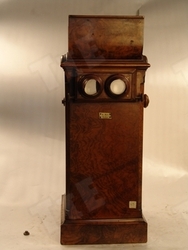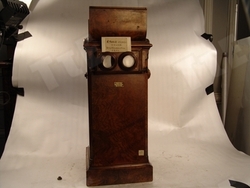Pre-Cinematography
Return
Table Stereo Viewer
This is a device whose design is based on the hand-held stereoscope, which was first introduced by Sir Douglas Wheatstone in 1838 and was further developed by Oliver Wendell Holmes as the "Holmes Stereo-viewer". On its design are based the more recent ‘Mutoscope’ (1985) that projected paper images and the 'Kinetoscope' (1891), that projected film. Through a double-lensed view-finder (“peep-hole machine”), the viewer sees a number of glass slides (36 to 50), which are connected by an axonal band, following the same rationale as the ‘hand stereoscope’: two images, one next to the other, photographed from similar angles of view, are placed on a base in front of a set of lenses adapted to the view-finder. An outstanding piece of wooden cabinetry, with a particularly sophisticated system of prisms for the image to arrive at the view-finder. The slides are lit by a system of 'opaque glasses ', at the back and the top part of the device, which is transmitted via prisms to the internal mechanism. The user/viewer experiences a feeling of ‘three-dimensional’ image and motion, as well as an illusion of depth. It probably belongs to the period 1860-1870, while a similar artifact can be found at the J. Paul Getty Museum (Los Angeles).






